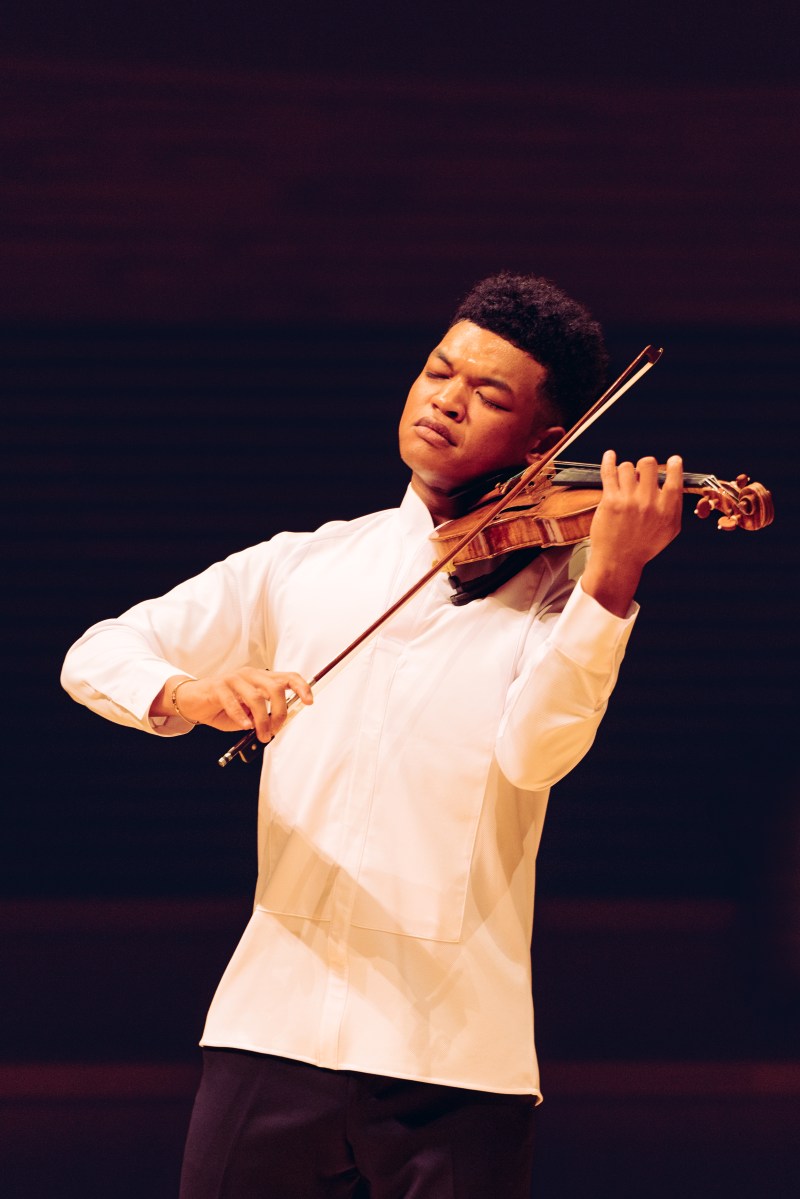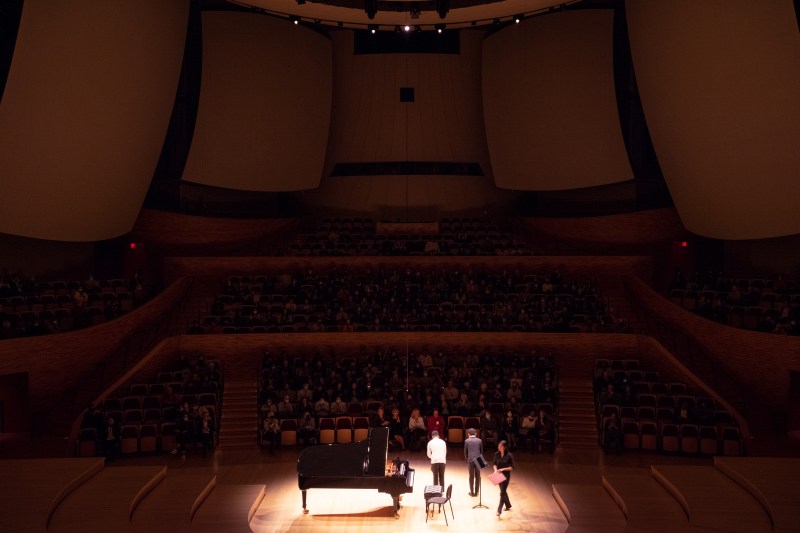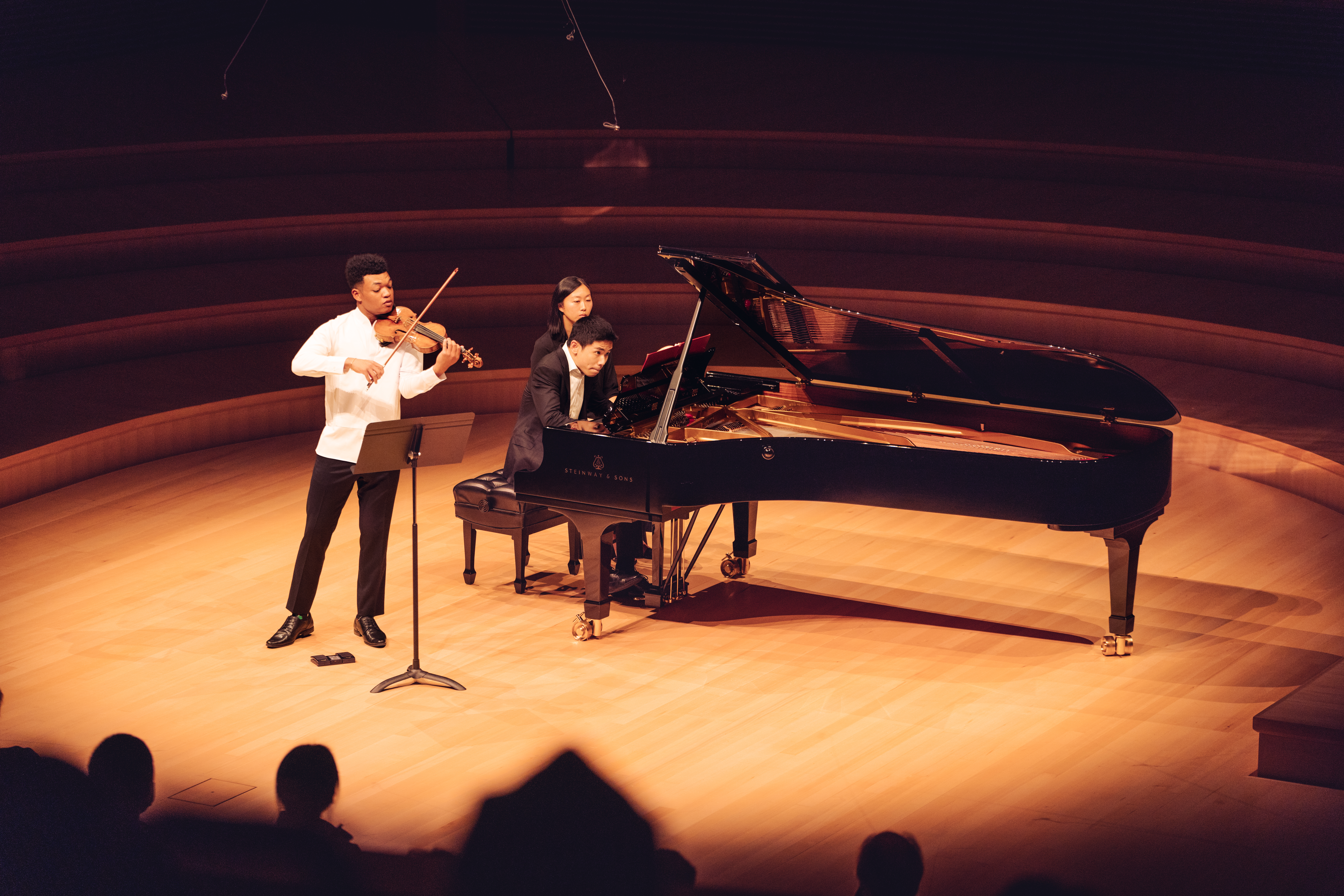Stanford Live welcomed 26-year-old American violinist Randall Goosby to Bing Concert Hall on Wednesday night, accompanied by 24-year-old Chinese pianist Zhu Wang. The performance was historical and memorable in several ways: for one, it was the Northern California debut of this young duo. Additionally, the eve of the concert marked the ten-year anniversary of the establishment of Bing Concert Hall on Stanford’s campus.
However, it is not Goosby’s first performance at Bing: he fondly recalled performing at this concert hall ten years ago as a member of renowned violinist Itzhak Perlman’s youth strings program. Just a teenager, Goosby recalls being fascinated with the beauty of the concert hall.
Goosby and Wang boast an impressive list of accolades within their already-extensive careers, with Goosby currently pursuing an Artist Diploma at Juilliard, continuing under Perlman’s instruction, and Wang being the first prize recipient of the 2020 Young Concert Artists International Auditions, and having already made appearances at Carnegie Hall and Lincoln Center. Yet when the two first walked onto the stage, I was struck by their youthful and charismatic energy. As a college student, it was a pleasant surprise for me as an audience member to see younger, fresh faces on stage, not much older than myself.
Given their charisma and emotional vitality, Goosby and Wang stand out as young musicians pioneering the field of classical music for future generations. In an era where younger classical musicians are sometimes too embarrassed to fully emote when performing, I found their dedication to preserving this aspect of classical music very welcome.
Goosby and Wang’s performance was my favorite of the ones I have covered so far this quarter. The duo clearly showcased great chemistry and played off of each other, which was met with a warm response from the audience, who barely filled up half of the seats in Bing. Nevertheless, the small audience actually created a more intimate atmosphere, especially with Goosby’s witty banter.
Yet perhaps what I respect and admire most about Wednesday’s performance was its purpose of shining a light on underrepresented minorities buried within the history of classical music. Goosby clearly did his research when selecting repertoire that reflected this reality, and I appreciated him sharing the stories behind each one with enriching commentary. We often see classical music as Eurocentric; in reality, it pulls overlooked inspiration from all races, especially from African roots. As Goosby so eloquently described in the meet and greet after the concert, “[What we hoped to accomplish tonight] was to introduce new music that is not really new.”
The duo opened with the “tantalizingly brief but brilliant” works “Deux morceaux: Nocturne” (1911) and “Cortège” (1914), by French composer Lilli Boulanger. Goosby eased the audience in with a warm tone and tender glissandos that flowed like honey from the very first notes.
Next, Goosby performed Ravel’s Violin Sonata No. 2 in G Major. His coloration of the first movement made it obvious to me (as a long-standing fan of Itzhak Perlman) that he is indeed Perlman’s student, as he had Perlman’s signature vibrato!
In the third movement, “Perpetuum mobile: Allegro,” Goosby showcased his virtuosity with stratospheric octaves. However, the second movement, “Blues: Moderato,” was a beautiful fit for what I came to interpret as the broader purpose of his program: to highlight artists and genres of color, both inside and out of the bounds of classical music.

Goosby commenced this movement with what initially appeared to be “graceful and lyrical” light pizzicato in a major key. When accompanied with the creeping chords of the piano in a minor key, it instead came to take a much more mysterious, and somewhat sinister, mood. Further, by mimicking the sounds of a banjo and saxophone, the music was an homage to the ‘‘nerve-wracking virtuosity” of the African American jazz musicians in 1920s Paris that inspired Ravel in the composition of this piece. Playful movements and facial expressions by Goosby and Wang further resurrected this image.
After giving a stunning rendition of Ravel’s sonata, Goosby lightly joked that he and Wang were “warmed up [enough]” to perform their next piece, Suite for violin and piano (1943) by the African-American composer William Grant Still. Wang took the bull by the horns by diving into the first movement, “African Dancer,” with a loud piano entrance that made me jump in my seat.
Goosby and Wang did a 180-degree flip in persona for the next movement, “Mother and Child.” Its lullaby-like main melody was played with such tenderness that it was easily the highlight of the first half of the concert in my ears.
Next, in “Gamin” (a French term for streetwise children), Goosby embodied the young African-American child mischievously spending his childhood days fooling around. It featured grating spiccato near the bridge that emulated a fluid yet controlled splattering of a paintbrush. When it concluded, it took everyone in the audience a moment to realize that it was time to clap: I looked around to see my fellow audience members still transfixed in the aftermath of the duo’s climactic performance.
After the intermission, Goosby performed Beethoven’s Violin Sonata No. 9 in A Major, “Kreutzer.” He described it as a “massive” piece, not only in its domineering sound, but also in its backstory. Goosby explained to us that Beethoven had originally dedicated it to Afro-European child prodigy and virtuoso violinist George Bridgetower. After the two had a falling out over a woman, Beethoven changed what was “Bridgetower’s Sonata” to “Kreutzer’s Sonata” out of spite.
I found it touching and memorable that Goosby dedicated that night’s performance to Bridgetower, whom he described as being “forgotten until five years ago.” Bridgetower allegedly sight-read and performed the sonata at 8 am the first time he was exposed to it, a remarkable feat that Goosby warranted as “giving credit where it’s due!”
Wang really shined in the second movement, showcasing a twinkling melody in the upper registers of the piano. Here, it was Goosby who accompanied him.

After their well-earned standing ovation, the two put on an encore performance of “Estrellita,” Spanish for “a little star.” As Goosby described, the piece was originally composed by Mexican composer Manuel Ponce, but was later arranged for violin and piano by the renowned American violinist Jascha Heifetz. Having heard it performed in a restaurant by a local mariachi band in Mexico, Heifetz wrote down the name of the song on a napkin and returned to Los Angeles to record it in the studio.
Wednesday’s final performance was just as touching as this story. Goosby’s fluid bow changes, as well as the intertwining melodic trade-off between him and Wang, left the audience in a trance and let the audience release a collective “aww” at the conclusion of the performance.
Editor’s Note: This article is a review and includes subjective thoughts, opinions and critiques.
